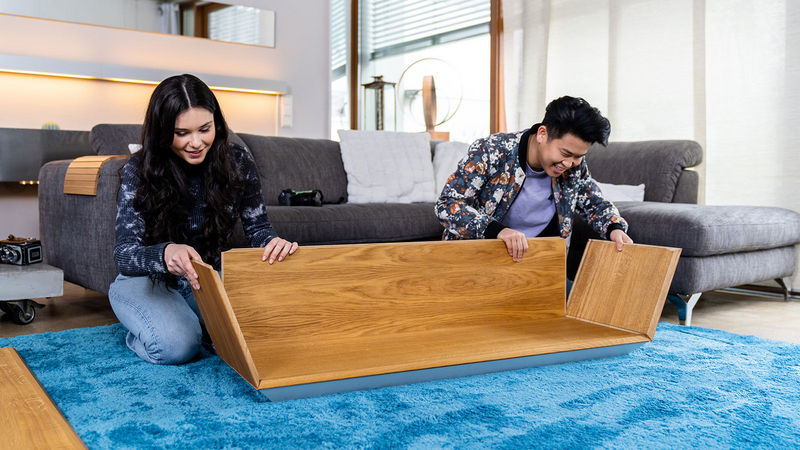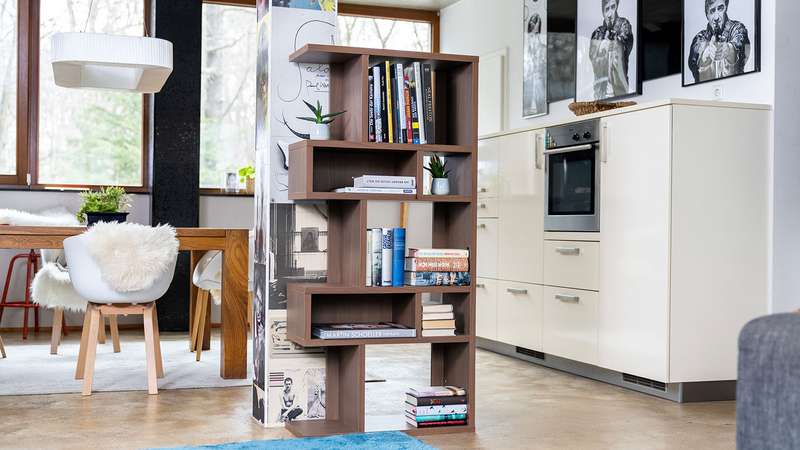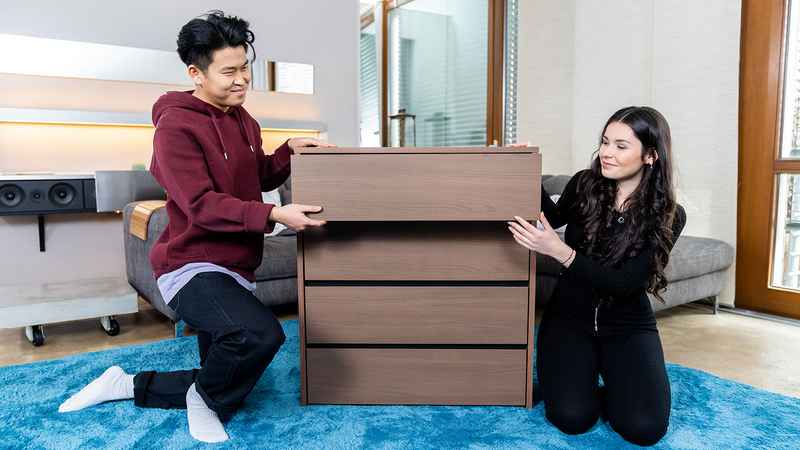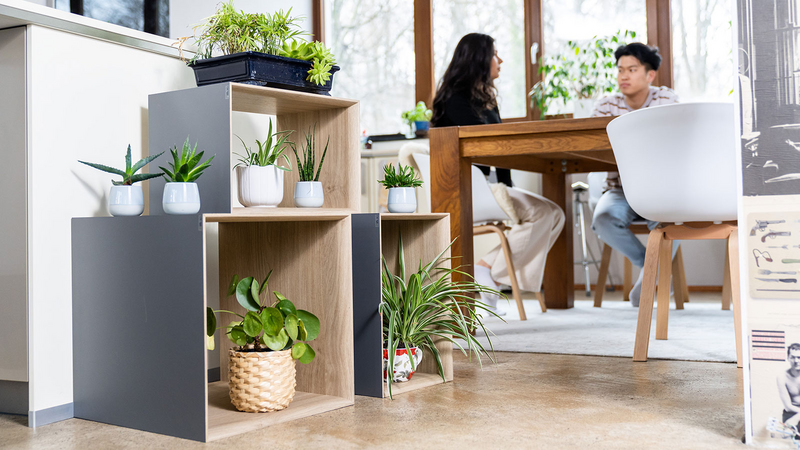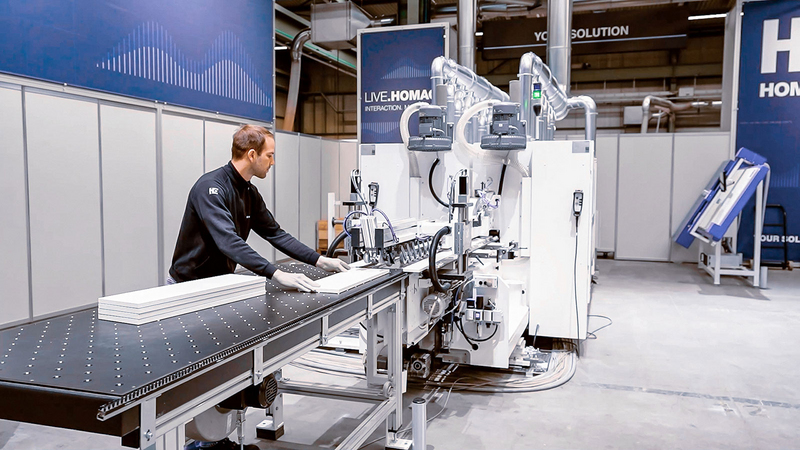One click can change a lot
When an idea meets people that drive it forward enthusiastically, it can change a lot. "Threespine" is just such an idea. And its protagonists come from VÄLINGE and HOMAG, as well as from TNC. What people have long appreciated about flooring is now intended to convert the domestic furniture sector: the click system.
In Germany alone, the furniture market in the last four years exceeded a market volume of more than EUR 40 billion. By 2023, sales of home furniture will make up around half of the volume. A large proportion of the furniture is delivered as flat-pack furniture and built by the end users themselves or professional furniture fitters. Traditionally, cams, concealed hinges and dowels are used. But why not get rid of these fixtures and build the furniture more quickly and easily? The click system offers this opportunity. The success story for flooring proves this impressively. With regard to furniture, some people certainly still have questions about the assembly principle: about performance characteristics such as stability, for example, about quality and sustainability. Or questions about production and the associated machines. The questions extend to sales and the markets. What do the answers look like?
The idea from the north …
The Threespine furniture click technology was developed by the Swedish company VÄLINGE, which has many years of experience with mechanical connections systems and technologies for flooring. "We are now transferring this know-how to other fields of application, concentrating in particular on furniture elements. Our aim is to change the furniture market," says Johan Hallin, Key Account Manager for Europe at VÄLINGE, highlighting the situation. "With Threespine, the customer doesn't need screws, dowels or glue when building furniture. We use a flexible, fiberglass-reinforced locking element that is integrated in the panel." During assembly, this plastic element bends inward, for example, when a side wall is pushed in, to connect it to the base. When the side wall reaches its end position, the plastic element bends back and the connection is established. "Thanks to Threespine, the furniture is more stable than with conventional connection systems," says Mindaugas Zacharenko, Project Manager Furniture at VÄLINGE. "The look also benefits, because the products don't have any visible dowel holes. However, the biggest advantage is in the fast result. Even lay people can build the furniture without any problems and use it immediately. And they're ten times faster than with conventional assembly methods." Dismantling the furniture – when moving house, for example – is just as uncomplicated as assembling it. "A disassembly key slides into the inner profile groove, releasing the plastic element and thus the connection between the furniture parts," describes Hallin.
… the machines from Germany
While the idea for Threespine came from Sweden, the production technology comes largely from Germany. VÄLINGE and HOMAG have been working together on the production of parquet and laminate flooring with the click system for a long time. They're now doing the same for click furniture. Here, with flexible production systems, Threespine can be scaled for a wide range of users, production concepts and furniture systems: from mass producers to family businesses with small series to batch size 1 producers. The only additional processing step for Threespine production consists in groove milling of the profiles and the insertion of the plastic elements. "Depending on the scope of production, we can use machines with different throughput and level of automation," says Fabian Kalmbach, application technician in the HOMAG Group, highlighting the benefits. "When a new production line is put into operation, no additional machine is required because the unit required is already integrated in the new edge banding machines." Compact and robust one-sided or two-sided format machines are used with closely aligned units to ensure high performance and precision. The TENONTEQ D-500 double-end profiler, for example, is equipped with jointing and groove trimming units and a separate inserter that inserts the plastic springs into the grooves. The TENONTEQ D-500 can be used to profile and put grooves and notches in furniture parts such as bases, tops, side walls or rear walls, as well as to insert springs that, thanks to the locking function, ensure high stability.
Suitable for companies of any size
One of the current users of the Threespine technology is the Swedish company TNC Components. "We wanted to bring something new onto the market. For the kitchen area, for example, where not much has changed in recent years," says Jarkko Ala-Kanto, CEO at TNC Nordic Oy, the parent company of TNC Components. "Now that we have installed new machines and adapted existing machines, we now produce click furniture mainly in series production." Zacharenko, who was the project manager responsible for TNC, explains the situation in more detail: "For this series production, we used a double-end profiler and a profiling system for thin rear walls. We also adjusted a processing center for producing samples, although it was very easy to implement this with the tool set for profiling."
As a technology that is comparably easy to install, Threespine is suitable equally for smaller and larger manufacturers – as well as in addition to existing connection technologies. "However, to integrate Threespine in a production environment, the individual circumstances of production must be looked at," emphasizes Kalmbach. "Each individual situation has to be evaluated precisely with regard to quantities and the type of parts. The user should also discuss with VÄLINGE which type of license is suitable for them. We then check whether a single machine or an automatic production line is suitable and create a corresponding offer."
TNC Components started producing furniture around 70 years ago. Twenty years ago, the company set itself up increasingly for flat-pack furniture, before then ten years ago, starting assembly in the factory and delivery of finished products to customers. "With the click furniture, we can now go back to producing flat-pack furniture," emphasizes Ala-Kanto. "We then don't need as much space for large projects, the logistics are easier, and we have less damage." VÄLINGE and HOMAG supported his company extensively with the necessary changes to the production lines. Today, the click technology is used above all to produce cabinets, starting with kitchen and bathroom cabinets, closets and cabinets with sliding doors. This is because according to Ala-Kanto, the most sustainable effects would result from larger parts.
Simply easy
Looking at the end customers and the sales channels through which they receive their furniture, changes can also be seen here. "New routes are opening up," observes Hallin. "Along with a different purchasing behavior that will also accelerate the process of furniture assembly." Burger shares this view and adds: "With the sales channels that are currently changing, manufacturers can sell their click products in different designs and on different markets. In the future, flat-pack furniture will of course be the largest market. But even furniture that is produced individually is an attractive market segment." According to Burger, click furniture is ultimately interesting for every group of end consumers, particularly for younger people. He continues: "Young people move often, and being able to dismantle and then reassemble their furniture quickly makes this easier. They are quickly at home again." He also thinks the click furniture is interesting for older people, in situations where individual solutions are required, for example. But even without such constellations, thanks to its practicality and high-performance characteristics, click furniture is encountering increasing acceptance. Customers are also increasingly planning their furniture themselves using online tools provided by the manufacturers. "This is all accompanied by an increased interest from retailers, who benefit from the rapidly growing field of e-commerce and omnichannel sales," says Hallin. "Last but not least, purchasing behavior is changing because the overall process is becoming increasingly important: if you've ordered something easily and the product is delivered easily, then you expect the assembly to be easy too."
It's down to the user
For early adopters of the Threespine technology, the objective must be to introduce their products with a high-performance shop, to address new and existing customers and to reach a large part of the market with what they have to offer. Manufacturers of all types of flat-pack furniture in particular, but also construction and expo construction companies can benefit from the solution. Zacharenko is firmly convinced that Threespine will also play a part in professional assembly: "We have projects with companies that see big benefits in transport and assembly. With regard to performance characteristics, they rate flat-pack furniture as equal to prefabricated products."
"In terms of the regions that offer potential for the click technology, well of course, Europe is the first that comes to mind. This is where most of the manufacturers are located," highlights Burger. "Beyond that, I see the greatest potential in the Asian market. Not just because of the high population rates, but also because furniture changes quickly there." Demographic factors are also embedded in such regional development. "The younger generation has more of a 'click & meet' attitude," emphasizes Hallin again. "They don't want to spend the weekend putting together complicated furniture." Behind the practical alternative offered by VÄLINGE and HOMAG lies a mature technology. "Together, we want to apply this technology to an increasingly broader field and thus make life easier for manufacturers and users," emphasizes Zacharenko. "Everything is ready. Now it's down to the user."

